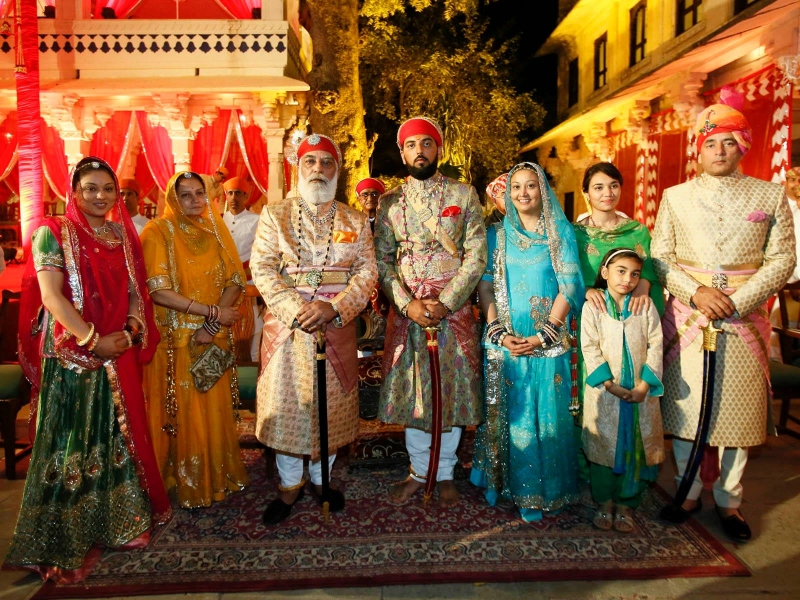Spectacular wedding ceremonies conducted at Bhubaneswar; historic coming together of two of India’s most respected families to celebrate the House of Mewar and Patna Balangir union

 Bhubaneswar, January 22, 2014: It was in the wee hours of the morning when the Pheras and Panigrahan Sanskars or the wedding rituals of Mr Lakshyaraj Singh Mewar of Udaipur and Ms Nivritti Kumari Singh Deo of Patna Balangir were concluded at the Janta Maidan, amidst the chants of prayers, music and drum-beats, marking the beginning of their life as a newly-wedded couple. At the mandap area, the parents – Mr Kanak Vardhan Singh Deo and Ms Sangeeta Devi Singh Deo – along with the priests of the House of Patna Balangir blessed the couple, resplendent in their wedding attire of red and yellow and aglitter with the traditional jewellery they wore. It was an incredible spectacle at the Janta Maidan where the entire Patna Balangir palace facade had been recreated, complete with its domes and chhatris, walls, screens and ramparts.
Bhubaneswar, January 22, 2014: It was in the wee hours of the morning when the Pheras and Panigrahan Sanskars or the wedding rituals of Mr Lakshyaraj Singh Mewar of Udaipur and Ms Nivritti Kumari Singh Deo of Patna Balangir were concluded at the Janta Maidan, amidst the chants of prayers, music and drum-beats, marking the beginning of their life as a newly-wedded couple. At the mandap area, the parents – Mr Kanak Vardhan Singh Deo and Ms Sangeeta Devi Singh Deo – along with the priests of the House of Patna Balangir blessed the couple, resplendent in their wedding attire of red and yellow and aglitter with the traditional jewellery they wore. It was an incredible spectacle at the Janta Maidan where the entire Patna Balangir palace facade had been recreated, complete with its domes and chhatris, walls, screens and ramparts.
Earlier, the guests witnessed the arrival of Mr Lakshyaraj Singh Mewar of Udaipur at the venue in a Rolls Royce. Looking dazzling in yellow poshak or robes, with rose-garlands across his chest, the groom was accompanied by his father, Shriji Arvind Singh Mewar and Mr Jyotiraditya Scindia, the scion of the Scindia family, who were attired in their traditional ceremonial robes and jewels to mark the historic occasion. The baraat party comprised almost all the important former royal houses of Rajasthan, Gujarat, Madhya Pradesh, Chhatisgarh, Bihar and Maharashtra; dressed in their ceremonial attire, carrying the family swords in hand, wearing their colourful safas and pugrees, it was a sight to behold. Every robe, sherwani or achhkan, necklace or bejewelled bracelet narrated a royal story of which the person wearing was immensely proud of. Probably never in recent history have so many former royal family members gathered together to celebrate the wedding ceremonies; the House of Mewar and Patna Balangir wedding ceremonies began in May 2013 and what a colourful and dignified climax it is now reaching in January 2014.
Under the night sky, as a waning moon rose up, the groom and baraat party were greeted with hundreds of musicians and drum-beaters whose never-ending crescendos led the way. This was the Baranugaman, marking the entry of the wedding guests or baraat party into the venue. Mr Lakshyaraj Singh Mewar of Udaipur, after alighting from the Rolls Royce, was seated atop the elephant in the silver howdah with the House of Mewar crest. The groom, atop the elephant, with the entire wedding or baraat party walking solemnly in front, seemed as if a traditional painting from the Court of Mewar had come to life! While Mr Kanak Vardhan Singh Deo did the honours of greeting Shriji Arvind Singh Mewar and the esteemed wedding guests, at every step of the Maidan’s pathway, the groom’s alighting from the elephant was also memorable as he was escorted by his wedding entourage and seated along with his father on the specially-decorated stage to be seated in the time-honoured Singhasan Arohan. The lawajma or the ceremonial signage of Mewar accompanied the groom and provided a befitting backdrop to the stage where the Patna Balangir priests began their rituals at the muharat or auspicious hour assigned.
For the wedding guests, it was now time to raise a toast to this matrimonial union of the House of Mewar with the House of Patna Balangir; at an exquisitely designed section of the Maidan, cocktails and dinner were served with music and dance matching the mood of festivities.
About Eternal Mewar
The House of Mewar, acknowledged as the world’s oldest-serving dynasty, has faced challenges, which have tested the maintenance of the Custodianship form of governance and the Custodian’s commitment to carry on serving as The Diwan of Shree Eklingnath ji.
In 1947 with India’s Independence and again in 1971, with the abolition of Princely Privileges, the office of the Custodian necessitated reinventions. In 1984 the mantle of 76th Custodian devolved upon Shriji Arvind Singh Mewar of Udaipur. The original status of Custodian, as provided in the Constitution of India, ceased to exist. The challenge, therefore, for Shriji Arvind Singh Mewar of Udaipur was to bring the different identities of inheritance under one umbrella.
Eternal Mewar is conceptualized to provide the vision for the 21st century; it expresses, embodies and encompasses the core values, principles and the legacy of the House of Mewar. Eternal Mewar covers all the activities of the House of Mewar.
Eternal Mewar has also emerged as a unique heritage brand exemplifying hospitality, cultural preservation, philanthropy, education, sports & spirituality for global audiences.
